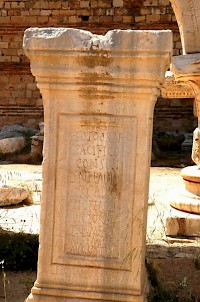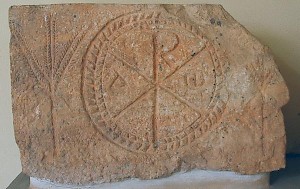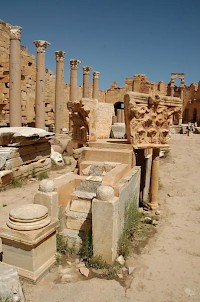Lepcis Magna: Late Antiquity
Q191504Lepcis Magna: Phoenician colony, later part of the Carthaginian empire, the kingdom of Massinissa, and the Roman empire. Its most famous son was the emperor Septimius Severus (r.193-211).
Crisis

After the reign of Septimius Severus, there is a sudden decline in urban investment. There are no spectacular new monuments and inscriptions typically refer to repairs, with one possible exception: the Hunting Baths, which were began during the reign of Severus and finished during the reign of Caracalla (r.211-217). Of course, the lack of new buildings may be an optical illusion. Only the emperor could recreate the city center; others would build new monuments in the suburbs, which have not been excavated.
However, in the entire Mediterranean world people built less in the cities and more on the countryside. Rome's enemies had become more dangerous, especially the Sasanian Persians, and new legions were built. Because state income was more or less fixed by the maximum agrarian output, the emperors had to look for a different solution: debasement - the same amount of silver was used to strike more coins, which were kept at the original weight by adding bronze. The result was inflation, and the funds needed for the maintenance of the urban evaporated. Rich people no longer lived in the city, but moved to their country estates.
The cities declined, and this is probably what happened in Lepcis too, although the countryside flourished. And although it is likely that the city no longer had 100,000 inhabitants, there are inscriptions that inform us about repairs, something that many other cities could not afford. On the Severan Forum, new statues and dedications continued to be erected.note
Fourth Century
The crisis continued until the beginning of the fourth century, when the emperors Diocletian and Constantine (r.284-305 and 306-337) guaranteed a long period of stability. Lepcis now became the capital of a new province, Tripolitana, and the governor ordered the building of a new bathhouse, which was never finished. He also ordered repairs to the Old Basilica and Macellum,note and built a city wall. This was necessary, because in the interior, new tribal federations had come into being, and they were dangerous.

As was common in the fourth century, the inhabitants of Lepcis Magna converted to Christianity. However, there had been Christians before: a bishop is mentioned in 258. The first churches have not been identified, nor do we know much about the opinions of the believers, who may have adhered to the Nicene Creed, or may have been Donatists.
Although fourth-century Lepcis witnessed an earthquake (306 or 310), a tsunami (365), and a serious war against the Austuriani, which is described in some detail by the historian Ammianus Marcellinus (more...), the city was not still wealthy, especially when compared to other Roman towns. Among the inscriptions from the Severan Forum are a dedication to the emperor Constantius II,note a statue for Flavius Archontius Nilus,note an honorific inscription to the emperors Valentinian and Valens,note and dedications to Arcadius and Honorius.note In the Villa Nile, new mosaics were made.
The key to Lepcis' comparative success is the fact that the countryside was well-organized and continued to produce massive quantities of olive oil. And this was the result of the development of the semi-desert by Severus (above). During the third century, the Third Legion Augusta had disbanded for some time, but the peasants had learned how to defend the land that had been given to them (more...). Lepcis benefited.
Late Antiquity
In the fifth century, the Lepcitanians got new masters: the Vandals, a European tribe that had fought itself a way through Gaul, Hispania, and Numidia and had settled in Carthage. For the first time since Tripolitana had been conquered by the Romans, it became a real war zone. Vandals on horse had to fight against Austuriani on dromedaries.

In 533, the Byzantine emperor Justinian sent his general Belisarius to reconquer this province. In his company was the historian Procopius, who states that part of Lepcis was by now covered with sand,note and adds that new fortifications were built. The arch that had, almost five centuries ago, been erected to honor Vespasian, now became the main city gate, and the Severan Basilica became a church, dedicated the Mary, Mother of God.
The olive oil production increased and the countryside was still wealthy, making Tripolitana an almost natural target for Laguatan and Arabic expansion. In 543, ten years after the Byzantine conquest, the Laguatan took charge, and the Arab conquest took place in 643. The regime change did not intervene with the economical or social structures. The linguistic change was small: many peasants still spoke Punic, and for them it was easy to learn Arabic. Except for a new religion, the predesert civilization that was based on careful water management and constant vigilance remained the same, and as long as Lepcis could export oil, it could be a wealthy city. However, now that Lepcis was occupied by the Muslims, who were at war with the European infidels - who was to buy the oil? Demand was falling, and the city dwindled away.
Literature
- Antonino Di Vita e.a., La Libye antique. Cités perdues de l'empire romain (1998 Paris)
- K.D. Matthews, Cities in the Sand (1957 Philadelphia)
- Erwin Ruprechtsberger, Die römische Limeszone in Tripolitanien und der Kyrenaika, Tunesien - Libyen (1993 Aalen; Limes Museum)